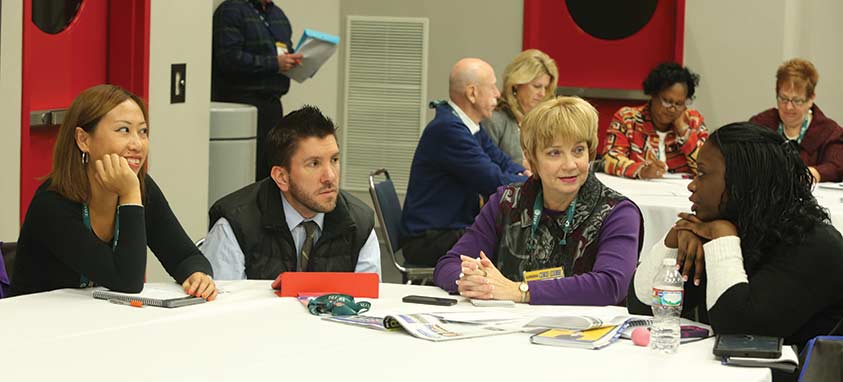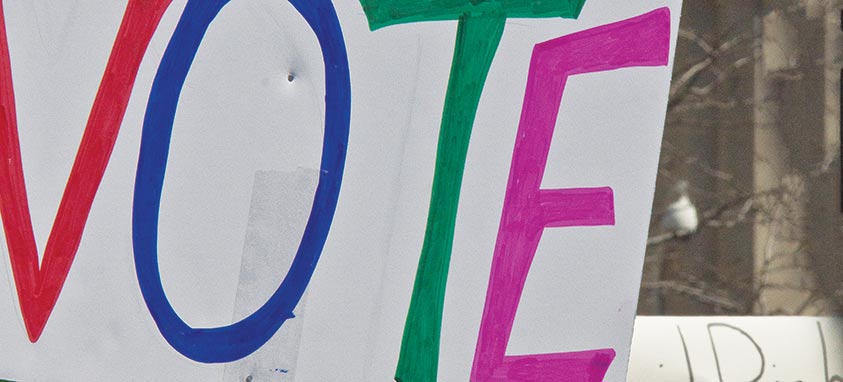The meetings industry is making efforts to promote diversity, but still faces many challenges.
The world’s becoming an increasingly smaller place, with the Internet linking people virtually everywhere and flights connecting not only major cities, but also less populated—and even remote—areas.
This has had a major impact on the meetings industry, which now has many more choices of cities and venues to schedule meetings and conferences, and is increasingly attracting more people from throughout the world. So, professionals in the industry have needed to develop a greater understanding and appreciation of cultural differences to better work with each other and accommodate attendees.
“Attention to cultural differences has been a hot topic in the meetings industry for several years, since most events are increasingly global in scope and meeting planners have a need to be culturally sensitive,” says Carina Bauer, CEO of IMEX Group. “However, over the past 10 years, other diversity issues and opportunities have also come more strongly to the fore—women’s leadership, generation trends, sexual orientation and others.”
The industry has been accelerating its efforts to educate professionals about the many types of diversity, and some specific efforts have helped to boost it. The industry still has a long way to go, however.
“The meetings industry has both a desire and a need to understand and reflect diversity more fully,” Bauer says. “I believe that over the past few years, we have seen more interest and understanding of the issues and opportunities. The next step is to start to more consciously and consistently factor diversity into meetings, events and conference programs, with the goal that this becomes more and more ingrained over time.”
We focused on some of the main types of diversity—racial, cultural, gender, sexual orientation and age group—to show specific efforts that have been made and the challenges that remain.
Like this content? Click here to get it Delivered FREE to your Inbox or your Mailbox
Racial
The meetings industry is gradually becoming more racially diverse, but few minorities serve in leadership roles. For instance, less than 2 percent of the convention and visitor bureaus in the United States are led by an African American or a Hispanic; many minorities have sales positions that focus on international locations.
The National Coalition of Black Meetings Planners has boosted the careers of many African Americans by providing training, facilitating job referrals, exchanging lists of consultants and vendors, and sharing other resources (see “Smart Talk” on p. 30 for more information about this nonprofit organization).
Also, Marriott International—which has partnerships with the National Association of Black Hotel Owners, Operators and Developers and Asian American Hotel Owners Association—launched its Diverse Ownership Initiative in 2005 to introduce successful minority and women business owners to the hotel industry.
Marriott hosts Hotel Ownership 101 Sessions during the National Black MBA Association’s annual conferences. Also, twice a year, Marriott hosts the Diversity Ownership Summit to encourage minority hotel ownership.
“One of the main challenges is recruiting minorities to the meetings industry,” says Dan Williams, senior director of convention sales for Experience Columbus, which has actively promoted diversity in the Columbus, Ohio, area. “While there are many opportunities available, there is a lack of communication about those jobs. The industry as a whole needs to make the opportunities more widely known.
“Currently, while the industry has a diverse group of leaders, it is not reflective of society, based on the size of our industry. There is a lot of potential for growth and room for improvement, so we need to spread the word and start initiatives to encourage exploration in the industry at a young age.”
Federal and state court rulings have mandated greater diversity in many industries, including several factions of the meetings industry. Some CVBs also have helped to boost racial diversity.
PHLDiversity, part of the Philadelphia Convention and Visitors Bureau, provides scholarships to minority students studying tourism and hospitality, and offers a pipeline to many career opportunities.
Also, last year the San Francisco Convention & Visitors Bureau took steps to be more inclusive in its business dealings. The move was prompted by a threat made by the San Francisco African American Chamber of Commerce to boycott the city’s hospitality and tourism industries because it deemed that African Americans weren’t being afforded equal access to workforce, business and contracting opportunities in the industries.
Cultural
As more groups travel internationally and the workforce becomes more culturally diverse, one of the main challenges of the meetings and hospitality industry is to make everyone feel welcome.
“Just like in the main population, there are challenges in the meetings industry related to tolerance and acceptance, and carefully listening and taking into consideration differing viewpoints,” says Cathy Breden, CAE, CMP, executive vice president and chief operating officer for the International Association of Exhibitions and Events (IAEE).. “Regardless of whether it is cultural, racial or sexual orientation, listening and learning from one another is key. Certainly, every organization has its own ‘culture,’ especially in work teams understanding differences and commonalities.”
The International Association of Hispanic Meeting Professionals (IAHMP) created the Certified Diversity Meeting Professional designation in 2002 to meet the needs of industry professionals who work and do business with people all over the world. Recipients of the designation must have demonstrated a high level of experience, skill and knowledge that enables them to be “culturally fluent.”
“Becoming culturally proficient means understanding your customer, based on a specific knowledge of a person’s country of origin, cultural nuances and other traits such as gender and educational level,” says Margaret Gonzalez, IAHMP’s founder and president. “As an international organization, we recognize cultural fluency as critical for the success of meeting professionals. Connecting with customers is no longer a luxury: It’s a necessity. When you understand customers’ needs and preferences, you can more effectively win their loyalty.”
Also, spurred by the need to provide leadership opportunities for underrepresented groups in the meetings industry, Meeting Professionals International (MPI) partnered with the National Multicultural Tourism Council in 2001 to form the MPI Multicultural Initiative program.
Gender
In the 1990s, Christine Duffy—now president of Carnival Cruise Line in the Miami/Fort Lauderdale area—went before the MPI board to explain why she thought an initiative was needed to promote and support women in the travel industry. The board consisted almost entirely of men, and one of them asked a telling question: “Why do we need an initiative like this when women already make up so much of the workforce in the meetings industry?”
“I said that while the industry is full of women, the reality is, a very small percentage is in leadership positions or in senior management,” Duffy says.
One of the board members promptly contributed a significant amount of money toward the initiative and others followed suit. In 2001, Duffy founded MPI’s Women’s Leadership Initiative, which has helped to provide research and programs to help women in the meetings and hospitality industry advance in their careers. She believes that considerable inroads have been made in promoting women to leadership roles, but that more progress needs to be made in some areas, such as providing wage equality for women.
Another organization, Women in Events, was founded this year to provide female professionals in the meetings and events industry with a collaborative place to share ideas, build solid professional relationships through empowerment and forge relationships to advance their professional careers.
Duffy emphasizes that women enrich the industry by bringing a style of leadership and management that differs from what men contribute. James Sun, an entrepreneur and diversity advocate who delivered a keynote address on diversity at IMEX America in October 2014, agrees with her.
“I think the next phase is to discuss gender differences as a strength,” he says. “Men, women and transgender all bring different inherent strengths and weaknesses, and the goal should not be about making everyone the same, but [instead] leveraging the strengths of each group.”
Sexual Orientation
While the meetings industry has had a fair amount of diversity in sexual orientation for some time, it has not been a focal point of many discussions or efforts to ensure equality.
“The topic of sexual orientation has not been discussed in the larger scope of the industry,” Sun says. “We need to hear impact testimonials from individuals who have struggled and overcome challenges in their life with sexual orientation. This then needs to be taken to a more macro level of building tolerance and community for anyone who is different and unique.”
A few convention and visitors bureaus have been actively promoting diversity in sexual orientation. It’s been central to the mission of PHLDiversity.
“Thirty years ago, the LGBT community’s impact may have been profound, but it was not yet clearly defined,” says Greg DeShields, PHLDiversity’s executive director. “Associations and destinations face the problem of not having a well-established strategic plan to pursue and cultivate this market segment and to address the needs of the LGBT attendees.
“While many of these meetings are like any other, there may be value-added options specific to LGBT groups that destinations could offer. CVBs across the country are realizing this and rethinking their approach.”
PHLDiversity has invested considerable resources to research this market segment and has initiated outreach efforts.
Another CVB, Visit Seattle, launched a campaign called “Marry Me Seattle” in 2014.
“Visit Seattle invited LGBTQ visitors here to showcase our welcoming and progressive culture,” says Rob Hampton, the CVB’s senior vice president of convention sales and services. “Seattle welcomes diversity with open arms and can serve as a great example to other cities that are looking to be more progressive in the meeting and convention business.”
The highlight of the campaign was a sweepstakes in which four couples won lavish weddings in Seattle that included airfare, hotel stays and a ceremony with music, photography, champagne, beer, food and free local transportation. More than 1,000 out-of-state, same-sex couples entered the sweepstakes.
Age
As many seasoned meetings professionals retire and near retirement, the industry has been making a strong effort to recruit talented young people to keep it moving forward. This has resulted in both a blending and a clashing of different styles and preferences.
One of the most interesting panel discussions at MPI’s 2014 World Education Congress in Minneapolis focused on the generation gap in the workplace and at meetings. The panel consisted of four millennials, including Joe Martin, partner and conference director for BDI Events, a full-service events company based in Los Angeles.
Martin and other panelists discussed a wide range of generation-gap issues, including the differences between younger and older generations, and how they can work constructively together.
“I think our industry has made large strides in focusing on the next generation of meeting industry professionals,” Martin says. “We are finally starting to see the mix of our seasoned professionals with new ones. The balance of the two is the perfect pairing to make our meetings more successful with their diversity.”
Aspiring young professionals have been characterized as highly ambitious and sometimes impatient to move up the ladder in the industry, partly because increasingly more people—including those in leadership positions—are working into their 60s and 70s.
“I think that today there is a lot of pressure on women especially, but on men, too, coming out of school,” Duffy says. “They all ask, ‘What is the linear path that’s going to get me to the big job?’ The truth is, it’s probably not a linear path: It’s a journey, and they need determination and stamina, and the help and faith of others, to achieve their goals.”
Some of the industry’s major organizations have focused on the need to develop young talent. Destination Marketing Association International’s (DMAI) “30 Under 30” program—a collaborative effort with founding partner SearchWide and supporting sponsors IMEX and USAE—is an example. It annually identifies 30 individuals who are 30 years of age and under, and provides them with valuable industry networking and professional development opportunities throughout the year.
Also, IAEE has a Young Professional of the Year Award that recognizes the excellent work of someone who has helped to advance the standing of young professionals in the industry.
Summing Up
The efforts being made to create a more diverse meetings industry are encouraging, and are vital to its success.
“Diversity allows for a greater influx of ideas in the meetings industry,” Hampton says. “The variety of opinions that comes from having a diverse group of people present helps to keep large, convention-size meetings exciting and fresh.”
Diversity alone will not bring about significant change, however, unless all people feel welcome and appreciated. Sun feels that this involves embracing and encouraging the uniqueness of every person. This requires all industry professionals to open their hearts and minds—and do some soul searching.
“We need to do some ‘surgery’ to help identify and reconstruct the hidden biases that all of us have,” he says. “Diversity needs to go beyond corporate policy; it requires each one of us to take a deep look inside our souls. When the industry sees diversity not as a topic, but rather as a human philosophy, then we will begin to really make some changes.”
A CVB Program That’s Making a Difference
PHLDiversity, formerly the Philadelphia Multicultural Affairs Congress, was founded in 1987 as a division of the Philadelphia Convention & Visitors Bureau to help attract more multicultural visitors, including meeting attendees, to the city.
The program promotes Philadelphia as an ethnically diverse visitor destination, and by encouraging multicultural business and social responsibility, PHLDiversity helps the city’s communities benefit from the hospitality and tourism industries. It maintains an ethnically diverse membership that represents an array of Philadelphia’s corporate, government and social communities.
“As a division of the PHLCVB, our bottom line is foremost to increase the city’s share of the meeting and convention industry and fill hotel rooms,” says Executive Director Greg DeShields. “PHLDiversity was created to ensure that as these goals are met holistically, meeting and hotel bookings accurately reflect the shifting economic and cultural climate of our country. Diversity is, after all, an ever-evolving portrait and demands ever-evolving practices.”
PHLDiversity has developed several programs, including the Distinguished Diversity Series, which enables hospitality professionals to hear from world-renowned scholars, dignitaries and diversity experts to help inspire a more inclusive community.
DeShields believes that the program has made inroads in the community.
“Within PHLDiversity and the work that we do with meeting groups, we have seen a greater appreciation for diversity,” he says. “PHLDiversity actively builds community relationships between meeting planners, convention leaders and local groups who share a culture and ideals. We work in tandem to create connections for meeting planners, whether this is with the local media, minority-owned businesses or political officials.”
The Religious Freedom Restoration Act (RFRA) debacle this spring in Indiana could have been Visit Indy’s worst nightmare, but President and CEO Leonard Hoops is focusing on the positive. “We won’t pretend that it didn’t have a negative impact, but we can now step back and see how our community worked together,” he says. “It was an incredibly divisive issue, but in the end it was positive because we were all so aligned and it elevated the discussion for marriage equality and LGBT rights in our state.”
Hoops wants planners to know that there is no need to shy away from Indianapolis as a meeting destination. “The controversy was well covered by the media, but the fix was not covered as much. We want prospects to know factual information,” he says.
The Background
In January, the Indiana Senate introduced SB101, the state’s version of the federal RFRA. Opponents of SB101 feared it could legally permit Indiana businesses to refuse service to gay and transgender customers for religious reasons. In early February, Visit Indy joined other organizations in formally opposing the measure, expressing concern that it would portray Indiana as unwelcoming, and influence planners to take their business elsewhere. “We felt RFRA went against the nature of hospitality and it didn’t align with our city’s Human Rights Ordinance, which has been around for a decade,” Hoops says.
Despite vocal opposition from many who viewed the law as discriminatory, lawmakers in the General Assembly pushed the bill through and it was signed by Gov. Mike Pence (R) on March 26. There was an immediate backlash. “A lot of lawmakers didn’t anticipate public reaction to the law would be that strong, even though we predicted it,” Hoops says.
Calling itself The Indy Welcomes All coalition, the CVB partnered with the ACLU of Indiana, the Indy Chamber, the Indiana Restaurant & Lodging Association, key business leaders and Indianapolis Mayor Greg Ballard to amend the legislation, which was not scheduled to go into effect until July 1. “We worked around the clock, every waking moment, to get that legislation amended. We had a huge stake in the matter. So did the big players on the business side, who have to recruit talent to live and work here,” Hoops says.
The Indy Welcomes All Coalition redoubled its efforts to communicate to leaders at the State House and Gov. Pence about how the state’s RFRA would negatively affect Indiana’s economy and harm the 75,000 Hoosiers who depend on tourism for a paycheck. The CEO of Angie’s List said he would not proceed with a $40 million expansion of the company’s headquarters in Indianapolis. Groups that already had meetings planned in the city publicly threatened to cancel and the Christian Church (Disciples of Christ) and American Federation of State, County and Municipal Employees (AFSCME) actually did so.
Gen Con, which has held its annual gaming convention in Indy since 2003 and is contracted through 2020, told Visit Indy it would consider meeting elsewhere in the future. That convention alone, says Hoops, drew 56,000 people to Indianapolis in 2014 and generated $49 million in revenues.
With Indianapolis set to host the NCAA Men’s Final Four basketball tournament beginning April 3, national pressure increased for legislators to act. On April 2, just one week after the original law was signed, they amended it by adding language that prohibits discrimination based on sexual orientation and gender identity, among other protected categories.
“The bottom line is that we held onto every group that was booked, and the two groups that originally cancelled rescinded,” Hoops notes.
But the Indiana Economic Development Corporation, which leads the state’s efforts to attract and retain businesses, is worried that the fiasco may have hurt Indiana’s image. It is reportedly paying global public relations firm Porter Novelli $2 million to help reestablish Indiana as a friendly state in which to do business.
A Record-Setting Year
The irony is that Indianapolis had been on a huge roll prior to the political debacle. “In 2014 we booked over 880,000 future convention and event room nights, shattering our record. To give you some context, in 2000 we booked 400,000 room nights,” Hoops says. One reason for the growth is that in early 2014, USA Today named Indianapolis the No. 1 convention city in America rankings.
Planners love the city, which boasts 12 hotels and more than 4,700 guest rooms directly connected to the downtown convention center via skywalks. More than 200 restaurants and pubs are within walking distance of the convention center. In addition, Indianapolis has a 250-acre urban park and a world-class zoo.
Mayor Ballard reiterates that the city has always welcomed the LGBT community. “Our city thrives because we have welcomed and embraced diversity,” he says.








